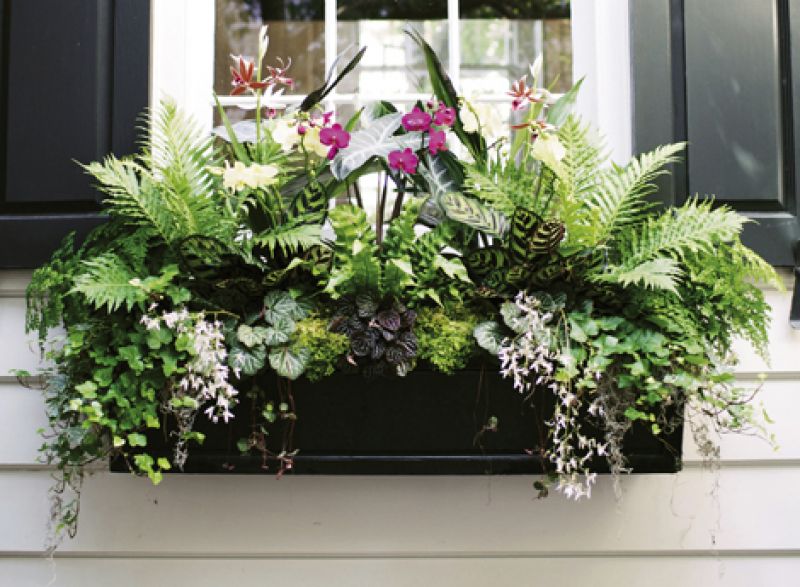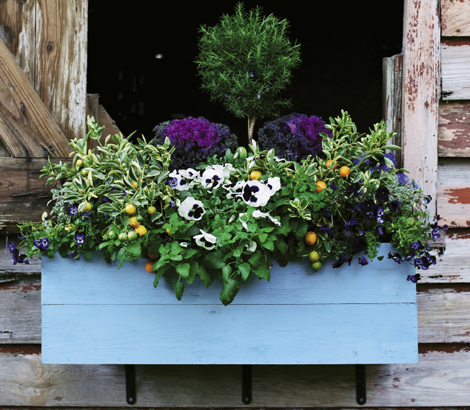
Plant List:
Alocasia ‘Nile High’
Bird’s nest fern (Asplenium nidus ‘Twist’)
English ivy (Hedera helix)
Maidenhair fern (Adiantum tenerum ‘Sleeping Beauty’)
Nun’s orchid (Phaius tankervilleae ‘Rabin’s Raven’)
Peacock plant (Calathea makoyana)
Peperomia (Peperomia caperata ‘Ripple’)
Phalaenopsis orchids, in purple and lime (Phalaenopsis amabilis)
Spikemoss (Selaginella)
Strawberry geranium (Saxifraga stolonifera)
Tree fern (Blechnum gibbum ‘Silver Lady’)
The Life Exotic: Landscape architect Glen Gardner puts a tropical twist on a classic look
When asked to design a window box for a traditional downtown home, local landscape architect Glen Gardner wanted to push the envelope with unexpected plantings. “So many people think of Charleston as a tropical oasis; they are often shocked that we are cold-tender here,” he says. “While landscape plants must withstand the elements, temporary plantings in pots and window boxes give us more opportunity for decorative expression.”
For this classic box situated in a protected courtyard with dappled light, Glen selected a profusion of exotics and other plants, many of which are typically found indoors, such as the various orchids and ferns. “This design actually will last and thrive through our spring and summer seasons,” he says. “And when the orchids lose their blooms in two or so months, just swap them out.”
Season: Spring through fall, replacing orchids as needed
Soil: Scott’s Osmocote Potting Mix
Light: Partial sun / partial shade
Water: Twice a week
Maintain: Prune to keep shape
Glen Gardner opened his practice, Glen R. Gardner Landscape Architect, in 2006. Although based in the Lowcountry, his work extends to Louisiana, North Carolina, and New York.

Plant List:
Buttercrunch lettuce
Kale (Brassica oleracea ‘Chidori Red’)
Lime balm (Melissa officinalis ‘Lime’)
Pansy (Viola wittrockiana)
Rosemary (Rosmarinus officinalis)
Spanish lavender (Lavandula stoechas ‘Otto Quast’)
Tricolor sage (Salvia officinalis ‘Tricolor’)
Variegated calamondin orange (Citrus reticulata ‘Calamondin variegata’)
From Farm to Window: Master gardener Joan McDonald plants an edible landscape for the seasons
“I have always loved this Mount Pleasant barn and envisioned a blue box filled with beautiful edibles to compliment its all-American rustic exterior,” says master gardener Joan McDonald. For it, she started with a cedar box from Hyams and painted it with CeCe Caldwell’s, a natural chalk and clay paint. “When planting edibles in a box, it’s important to use untreated wood and choose a nontoxic paint so they won’t leach chemicals,” she advises. From there, Joan says, the planting was fast and easy: “Purchase established plants from the garden center to give instant wow factor.” She picked greens, fruits, and herbs that will transition from the cool season to warm season with a few changes. After harvesting the kale and violas, replace with purple basil. The rosemary will continue to grow with the tricolor sage and variegated calamondins, and the lime balm will become the primary trailer.
Soil: Nutrient-rich, organic potting soil, such as Happy Frog
Light: Full sun
Water: At least twice a week, depending on Mother Nature
Fertilize: Top-dress the box with a flower-bed conditioner, such as Possum’s. Liquid feed your box every two to three weeks with an organic foliar spray such as fish emulsion.
Maintain: When swapping out plants, add nutrient-rich potting soil. Harvest and prune the plants to keep them in scale.
Joan McDonald volunteers as a Clemson Extension Master Gardener and writes a gardening blog, “Front Yard to Table,” for www.charlestongrit.com.

Plant List:
Diascia ‘Darla Orange’
Pincushion flower (Scabiosa columbaria ‘Pink Mist’)
Creeping phlox (Phlox subulata ‘Red Wing’)
Southmoon blueberry
Blue fescue grass (Festuca cinerea ‘Elijah Blue’)
Stonecrop (Sedum spurium ‘Red Carpet’)
Bromeliad (Neoregelia)
The Birds & The Bees: Lifelong gardener and horticulturist Jim Martin creates a safe haven for urban wildlife—bees, birds, and butterflies
Inspired to create “a beautiful space that provides wrens with food, water, and nesting areas,” horticulturist Jim Martin went for a chic cottage design, perfect for a bungalow, the backyard, or the beach. He started by fashioning his own “box” from hanging baskets (see caption above), then selected plants that would be aesthetically pleasing and provide for the birds. “The bromeliad’s cup-shaped reservoir serves as a water source,” he explains, “and the shrubby blueberry offers shelter when necessary, as well as a great food source in early summer.” He included materials, such as the blue fescue grass, that wrens can collect and layer in the nesting boxes. The flowers—Diascia, pincushions, phlox, and stonecrop—offer pollen and nectar for both bees and butterflies.
Season: Early spring through early summer
Soil: Available potting mix
Light: Partial to full sun
Water: When soil is dry; before plants wilt
Fertilize: Liquid feed every three weeks.
Maintain: Pick spent flowers for new growth.
Jim Martinis programs director at the Charleston Parks Conservancy and farms through Compost In My Shoe.